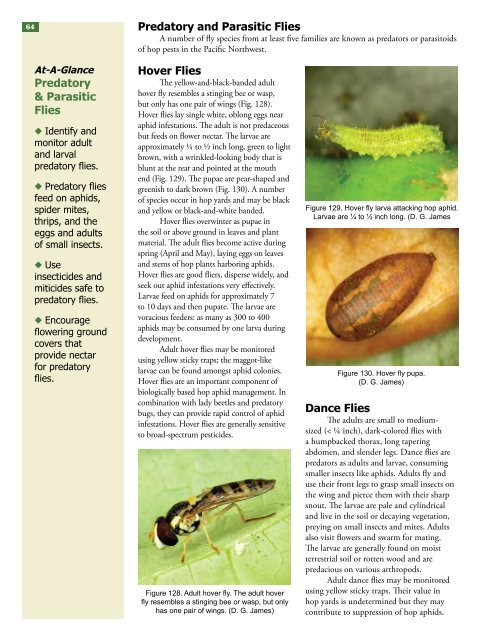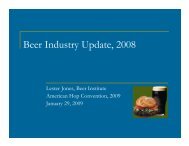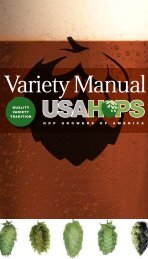Field Guide for Integrated Pest Management in Hops
Field Guide for Integrated Pest Management in Hops
Field Guide for Integrated Pest Management in Hops
You also want an ePaper? Increase the reach of your titles
YUMPU automatically turns print PDFs into web optimized ePapers that Google loves.
64 17Predatory and Parasitic FliesA number of fly species from at least five families are known as predators or parasitoidsof hop pests <strong>in</strong> the Pacific Northwest.At-A-GlancePredatory& ParasiticFlies◆◆Identify andmonitor adultand larvalpredatory flies.◆◆Predatory fliesfeed on aphids,spider mites,thrips, and theeggs and adultsof small <strong>in</strong>sects.◆◆Use<strong>in</strong>secticides andmiticides safe topredatory flies.◆◆Encourageflower<strong>in</strong>g groundcovers thatprovide nectar<strong>for</strong> predatoryflies.Hover FliesThe yellow-and-black-banded adulthover fly resembles a st<strong>in</strong>g<strong>in</strong>g bee or wasp,but only has one pair of w<strong>in</strong>gs (Fig. 128).Hover flies lay s<strong>in</strong>gle white, oblong eggs nearaphid <strong>in</strong>festations. The adult is not predaceousbut feeds on flower nectar. The larvae areapproximately ¼ to ½ <strong>in</strong>ch long, green to lightbrown, with a wr<strong>in</strong>kled-look<strong>in</strong>g body that isblunt at the rear and po<strong>in</strong>ted at the mouthend (Fig. 129). The pupae are pear-shaped andgreenish to dark brown (Fig. 130). A numberof species occur <strong>in</strong> hop yards and may be blackand yellow or black-and-white banded.Hover flies overw<strong>in</strong>ter as pupae <strong>in</strong>the soil or above ground <strong>in</strong> leaves and plantmaterial. The adult flies become active dur<strong>in</strong>gspr<strong>in</strong>g (April and May), lay<strong>in</strong>g eggs on leavesand stems of hop plants harbor<strong>in</strong>g aphids.Hover flies are good fliers, disperse widely, andseek out aphid <strong>in</strong>festations very effectively.Larvae feed on aphids <strong>for</strong> approximately 7to 10 days and then pupate. The larvae arevoracious feeders: as many as 300 to 400aphids may be consumed by one larva dur<strong>in</strong>gdevelopment.Adult hover flies may be monitoredus<strong>in</strong>g yellow sticky traps; the maggot-likelarvae can be found amongst aphid colonies.Hover flies are an important component ofbiologically based hop aphid management. Incomb<strong>in</strong>ation with lady beetles and predatorybugs, they can provide rapid control of aphid<strong>in</strong>festations. Hover flies are generally sensitiveto broad-spectrum pesticides.Figure 128. Adult hover fly. The adult hoverfly resembles a st<strong>in</strong>g<strong>in</strong>g bee or wasp, but onlyhas one pair of w<strong>in</strong>gs. (D. G. James)Figure 129. Hover fly larva attack<strong>in</strong>g hop aphid.Larvae are ¼ to ½ <strong>in</strong>ch long. (D. G. JamesFigure 130. Hover fly pupa.(D. G. James)Dance FliesThe adults are small to mediumsized(< ¼ <strong>in</strong>ch), dark-colored flies witha humpbacked thorax, long taper<strong>in</strong>gabdomen, and slender legs. Dance flies arepredators as adults and larvae, consum<strong>in</strong>gsmaller <strong>in</strong>sects like aphids. Adults fly anduse their front legs to grasp small <strong>in</strong>sects onthe w<strong>in</strong>g and pierce them with their sharpsnout. The larvae are pale and cyl<strong>in</strong>dricaland live <strong>in</strong> the soil or decay<strong>in</strong>g vegetation,prey<strong>in</strong>g on small <strong>in</strong>sects and mites. Adultsalso visit flowers and swarm <strong>for</strong> mat<strong>in</strong>g.The larvae are generally found on moistterrestrial soil or rotten wood and arepredacious on various arthropods.Adult dance flies may be monitoredus<strong>in</strong>g yellow sticky traps. Their value <strong>in</strong>hop yards is undeterm<strong>in</strong>ed but they maycontribute to suppression of hop aphids.








